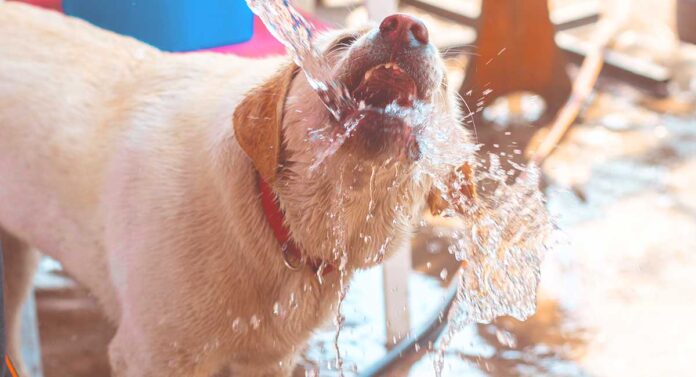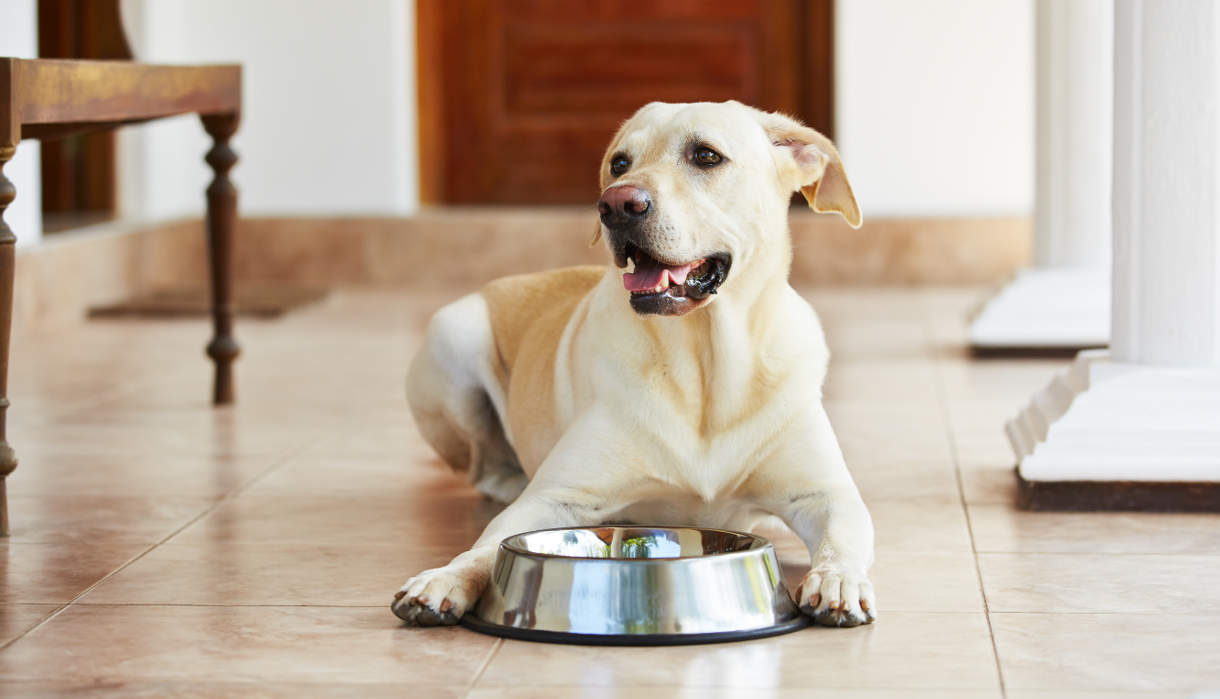How much water your dog drinks each day will vary hugely depending upon their activity level, breed and themselves as an individual. A healthy yet sedentary pup that spends a lot of time relaxing might only half empty their water bowl by evening. An active dog in a hot climate might well drink two large bowlfuls before lunch! It’s important to always have a bowl of fresh, clean water available to your pup from morning to late evening. Make a mental note of how often you are refilling it. There is only really a cause for action if their drinking behavior differs when the temperature and their energy levels have stayed the same.
Contents
- How to keep track of what your dog is drinking.
- Causes of excessive thirst.
- Signs of dehydration in dogs.
The average medium sized dog will drink around half a gallon of water a day. But this isn’t a hard and fast rule. Water intake is a good indicator of overall health and gives early warning signs of certain medical conditions. It is important to know what is normal for your Labrador and what to look out for when they start drinking more or less than usual.
Monitoring Your Dog’s Water Intake
You should notice if you suddenly start needing to refill it more than usual. However, our lives can get busy, and sometimes, we might not notice a change in drinking behavior. It is, therefore, a good idea to get a baseline so that you’ll know what is normal for your Labrador. This can be done by filling up their water bowl to the same level at the same time each day. Then, notice how much is left when you go to refill it the next day.
Developing this routine can help you stay on the ball with your dog’s water needs and consumption. Checking the water level at the same time each day will give you an accurate representation of how much your dog drinks.
How Much Water Should a Dog Drink?
As a rough guideline, normal water intake for a dog is around an ounce per pound (50 mL per kg) of body weight per day. That means that a 65-pound (30 kg) Labrador would drink approximately half a gallon (1.5 liters) of water per day. But every dog is different, so it’s important to know what is normal for your dog rather than dogs in general.
What Makes Labradors Drink More?
There are several factors that can affect the normal water intake mentioned above, including the following.
Diet
Your Labrador always needs fresh water available no matter what their diet; however, how much they drink will depend on the type of food they eat. Dogs that eat predominantly dry food and kibbles require more water than dogs on a wet food diet. It is perfectly normal for a Labrador (or any dog) on a canned or raw diet to drink less water than one on an exclusively dry food diet.
Weather
Water helps regulate body temperature. Dogs pant to cool themselves down by exhaling and releasing water through respiration. To compensate for this release of water, your Labrador will drink more in warmer weather.
Activity Level
When we exercise, we lose water through sweating and tend to drink more to make up for it. Dogs also require rehydration after exercise since they will have panted more than normal to help themselves cool down. If your Labrador naturally has high energy and activity levels, they will require more water than a couch-potato pup.
Medications and Supplements
Many common medications and supplements have side effects that may cause changes in daily water intake. Common anti-inflammatories, heart medications, and seizure medications can all lead to increased thirst and urination. It is important to be aware of these potential side effects and ask your veterinarian what to expect.
My Labrador Is Drinking More than Normal
When a dog is drinking more than usual, the first step is to rule out any obvious external factors as mentioned above. Drinking too much water can indicate a variety of health conditions such as a bladder infection, diabetes, or Cushing’s disease.
While you may think that drinking lots of water is pretty harmless, too much of anything is bad, including water. If a dog ingests too much water, which is commonly known as ‘water intoxication,’ they can experience dangerously low sodium levels in the blood, which is a dangerous condition known as ‘hyponatremia.’
The excess water can dilute and shift the natural electrolyte balance of the circulating blood causing blood cells to swell. Excess water consumption can have a sudden onset and can be life threatening. By monitoring your Labradors water intake regularly, you can judge subtle changes and be aware of when to contact your veterinarian.
My Labrador Is Drinking Too Much
There are several things to look for if you suspect your Labrador may be drinking too much, possibly leading to overhydration. These include loss of coordination and staggers, lethargy and nausea, bloat and vomiting, dilated pupils and pale gums, and excessive drooling. If left to develop, these signs can lead to difficulty breathing and collapse.
Be aware that drinking from their water bowl doesn’t necessarily account for all the water your dog consumes. Dogs that spend a lot of time in or around water may be drinking from other sources or consuming water incidentally. If your dog plays in water, they may be consuming water while fetching items or biting at the water. Similarly, if they like to be sprayed or drink from a hose, consider that water intake when evaluating their overall consumption.
My Labrador Is Drinking Too Little
If your Labrador suddenly decreases their water consumption, they are at risk of becoming dehydrated. If your dog isn’t drinking enough water this can also indicate certain conditions such as pancreatitis or parvovirus. Just like with drinking too much water, not drinking enough water will cause harmful imbalances in the body.
Water is vital for many functions, such as carrying nutrients throughout the body, aiding in digestion, and removing toxins from the system. If your Labrador gets dehydrated, the body won’t have enough water for these essential functions. Dehydration ultimately causes essential organs such as the kidneys and liver to stop functioning properly. If left in this state for too long, there can be irreversible damage to these organs.
Signs of Dehydration in Dogs
There are two easy ways to keep an eye on your Labradors hydration levels at home. It is beneficial to do these tests on your healthy Labrador so that you are aware of their baseline.
Skin Tenting
Skin tenting is a test of the skin’s elasticity and thus associated with hydration levels. This involves gently lifting the loose skin located between your Labrador’s shoulder blades and assessing how long it takes for the skin to return to its normal state. In a healthy dog, after the skin is lifted it should snap back to its original position almost instantaneously. If your Labrador is dehydrated, the skin will stay in a ‘tent’ for some seconds and be delayed in returning to the normal position. The longer the delay, the more dehydrated your dog is.
Mucous Membranes
The mucous membranes include the eyes, nose and mouth. They also serve as an indicator of adequate hydration levels. A healthy Lab’s gums will be pink and moist to the touch. If he is dehydrated, the gums may appear pale and feel dry and tacky when touched. A dry nose and/or dry, sunken eyes are also symptoms of dehydration.
If your dog tends to not drink enough and your vet has given her a clean bill of health, here are a few ideas to encourage drinking.
- Place her water bowl in places she likes to be.
- Praise her when she drinks water.
- Add chicken or bone broth to her water, but be sure to keep it fresh.
- Consider adding wet food to her diet.
- Soak dry food with water or broth before feeding.
- Consider getting a pet drinking fountain to make it fun (be sure to keep it clean).
The Labrador Site Founder
Pippa Mattinson is the best selling author of The Happy Puppy Handbook, the Labrador Handbook, Choosing The Perfect Puppy, and Total Recall.
She is also the founder of the Gundog Trust and the Dogsnet Online Training Program
Pippa's online training courses were launched in 2019 and you can find the latest course dates on the Dogsnet website





















Thank you so much, my 3 years old boy is gonna be so happy after I fix this.
Thank you so much, my 3 years old boy is gonna be so happy after I fix this.
Dehydration is a hard situation to handle in dog what do you do when your labrador breed have a low intake of water
Great article addressing an all-time relevant issue. This is because one of the ways to validate the good health of your dog is by paying attention to his water intake. In plain terms, if your dog usually losses interest in drinking water, this might be a sign of health complications from dental issues, fever, to more severe complications.
Unlike their feline counterpart, dogs have a craving for H2O better than a lot of animals. The amount that they consume, or should be consumed is determined by factors such as size, weather, age, breed, among others.
Labrador breed seem to have a common problem with water intake how do they cope with dehydration
So it’s interesting. My first guide dog was an english black lab, and he had a lot of issues including bone sarcoma cancer starting in his nose. But I remember even when I first got him, he didn’t like water much at all. We could be outside on a 90 dgf day, the sun was out and we were out there for a while, and he would take a sip of the bowl of water I gave him, but not much more than that. In the summer, we had to trick him into drinking water by giving him water melon. In contrast, my second guide, a yellow labrador retriever, I believe he’s an American one loves water. he’ll drink it all day, I can give him a ton but I only fill his bowl with food and some water twice a day, and other times I will give him some water especially if it is hot out. But honestly, I’m glad he actually drinks it because my first would lick the water a little and then turn away from it like no I’m good. No matter the weather or if he was panting, he didn’t like it. I keep track of the water supply for my dogs though, so I make sure this one has a good amount, but not so much he’s going to the bathroom all the time because I don’t want to over-water him at all. Stay hydrated, sure definitly. But as for other living things, giving someone too much water is not a good thing. There is a balance and that is hard to really figure out sometimes especially with labs and there love for things, but you will eventually figure it out. It also depends on the dog as well.
I am very nervous i bought a Lab puppy he is about 10 weeks old and he is always thirsty he drink 12 oz of water at a time if I let him. He is an indoor dog so he is in Ac all day so he shouldn’t be overly hot. I have an appt for vet but not for 3 days I’m worried he has cushings he also pees at least 2 times per hour I know because I take him outside every hour for potty training and he whimpers when he needs to go. He also has a pot belly he has been dewormed and is on continued meds of course since he is a puppy but something tells me something is wrong. I purchased him for 800 with AKC papers the contract states nothing at all about if the puppy has any disease.
Could you not try a plug in water fountain which simulates the tap but they would still have full access all day to water, they have some on zooplus which is where i got mine from, both my cats and dogs drink from it and took to it easily
Same happens with me, my 12 weeks old lab puppy never drinks water from the bowl!!
My 18 month old male Labrador never Leary to drink water from a bowl. He never drinks from a bowl if he’s severely thirsty and about to pass out. For him, the bowl means food and he takes nothing else from any bowl. I thought it’d get better when he grows but it never did. He only drinks from a running tap and that too not much as he chokes on it pretty quick while drinking and starts to cough (it’s always been like that). He’s otherwise perfectly healthy and fit. Just that somewhere, this thing is always troubling me. I feed him a home cooked diet of rice, meat and yoghurt, twice a day.